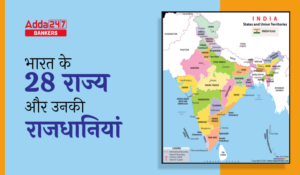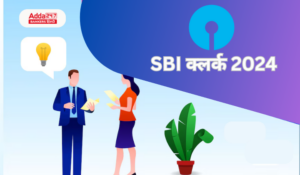जैसा की IBPS क्लर्क मुख्य परीक्षा निकट है और आप सभी उम्मीदवार अपनी तैयारी के अंतिम चरण पर होंगे, अधिकतम उम्मीदवार अन्य खंडों पर अधिक ध्यान देने के कारण एक ऐसे विषय को भूल जाते हैं जो आपको परीक्षा में कम समय में अधिकतम अंक प्राप्त करने में सहायता कर सकता है. सामान्य जागरूकता खंड में आपकी सहायता करने के लिए हम आपको सामन्य जागरूकता की प्रश्नोत्तरी प्रदान कर रहे हैं. जिसके साथ अभ्यास करके आप अपनी तैयारी को और भी बेहतर बना सकते हैं और परीक्षा में एक सम्मान जनक अंक प्राप्त कर सकते हैं. आज हम आपको 8 जनवरी 2020 की सामान्य जागरूकता प्रश्नोत्तरी प्रदान कर रहे हैं.
Q1. बैंकिंग विनियमन अधिनियम 1949____पर लागू नहीं होता है?
(a) राष्ट्रीयकृत बैंक
(b) विदेशी बैंक जिनकी भारत में शाखाएँ हैं
(c) दोनों (a) और (b)
(d) सहकारी बैंक
(e) दिए गए विकल्पों में से कोई भी सत्य नहीं है
Q2. __________ वह ऋण है, जिसमें संपत्ति या अचल संपत्ति संपार्श्विक(collateral) के रूप में उपयोग की जाती है।
(a) बंधक
(b) एसेट्स
(c) बैलेंस शीट
(d) लेजर
(e) दिए गए विकल्पों में से कोई भी सत्य नहीं है
Q3. बैंकनोट किसी भी मूल्य वर्ग में जारी किए जा सकते हैं लेकिन सिक्के किस मूल्यवर्ग तक जारी किए जा सकते हैं?
(a) Rs. 5000
(b) Rs. 1000
(c) Rs. 500
(d) Rs. 100
(e) Rs. 2000
Q4. भारतीय रिजर्व बैंक ने आर्थिक रूप से कमजोर वर्ग के लिए धन के उच्च प्रवाह(higher flow) को सुनिश्चित करने के लिए सूक्ष्म ऋण सीमा को बढ़ाया है। नियामक ने सूक्ष्म ऋण प्राप्त करने के लिए घरेलू आय सीमा को बढ़ा दिया है, जबकि उधार देने की सीमा को _____________ लाख प्रति योग्य उधारकर्ता को 1 लाख रुपये से पहले बढ़ाया है।
(a) 1 लाख
(b) 3 लाख
(c) 7 लाख
(d) 5 लाख
(e) 15 लाख
Q5. RBI ने जनवरी 1938 में अपना पहला बैंक नोट जारी किया, जिसमें जॉर्ज IV का चित्र था। इसका मूल्य वर्ग क्या था?
(a) Rs. 5
(b) Rs. 10
(c) Rs. 1
(d) Rs. 2
(e) Rs. 20
Q6. निगोशिएबल इंस्ट्रूमेंट्स एक्ट, 1881 की धारा 25 के तहत बैंक अवकाश किसके द्वारा घोषित किये जाते हैं?
(a) संबंधित राज्य के लिए राज्य सरकार
(b) बैंकिंग परिचालन विभाग
(c) केंद्र सरकार
(d) आरबीआई
(e) दिए गए विकल्पों में से कोई भी सत्य नहीं है
Q7. कर दाता का डेटा बैंकों से सीधे कर सूचना नेटवर्क (TIN) में प्रवाहित होता है। टीआईएन का प्रबन्धन कौन करता है?
(a) आरबीआई
(b) नेशनल सिक्योरिटीज डिपॉजिटरी लिमिटेड
(c) नेशनल सिक्योरिटीज डिफेंस लिमिटेड
(d) प्रवर्तन निदेशालय
(e) सीबीडीटी
Q8. CAMELS- में निम्नलिखित में से कौन सा शामिल नहीं है?
(a) पूंजी पर्याप्तता और संपत्ति की गुणवत्ता
(b) प्रबंधन और कमाई प्रदर्शन
(c) कर्मचारी प्रदर्शन
(d) तरलता और प्रणाली
(e) दिए गए विकल्पों में से कोई भी सत्य नहीं है
Q9. महात्मा गांधी श्रृंखला में बैंक नोट कब आरम्भ किए गए थे?
(a) 1991
(b) 1995
(c) 1996
(d) 2000
(e) 1997
Q10. भारतीय रिज़र्व बैंक द्वारा केवल _____के लिए अर्थोपाय अग्रिम प्रदान किए जाते हैं-
(a) केंद्र सरकार
(b) राज्य सरकार
(c) दोनों (a) और (b)
(d) दिए गए विकल्पों में से कोई भी सत्य नहीं है
(e) विदेशी सरकार
Q11. इन कथनों पर विचार करें: –
कथन I – RBI द्वारा मुद्रित होने वाले बैंकनोटों की मात्रा और मूल्य का निर्धारण किया जाता है।
कथन II – RBI द्वारा सिक्कों की मात्रा और मूल्य का निर्धारण किया जाता है।
(a) दोनों सत्य हैं।
(b) दोनों असत्य हैं।
(c) कथन I सत्य है, लेकिन कथन II असत्य है
(d) कथन I असत्य है, जबकि II सत्य है।
(e) दिए गए विकल्पों में से कोई भी सत्य नहीं है
Q12. भुगतान प्राप्त करने के लिए चेक में नामित व्यक्ति को किस नाम से जाना जाता है?
(a) पेयी
(b) ड्रोई
(c) ड्रावर
(d) एंडॉर्सि
(e) डिमांड ड्राफ्ट
Q13. कंपनियों, फर्मों, सार्वजनिक उद्यमों, व्यवसायियों के बीच किस प्रकार के खाते बहुत लोकप्रिय हैं, जिनकी आम तौर पर बैंक के साथ नियमित लेनदेन की संख्या अधिक है?
(a) सावधि जमा खाता
(b) बचत खाता
(c) चालु खाता
(d) उपरोक्त सभी
(e) दिए गए विकल्पों में से कोई भी सत्य नहीं है
Q14. पूंजी पर्याप्तता____ के आधार पर काम करती है?
(a) कुल मांग और समय देयताएं
(b) शुद्ध मांग और समय आस्तियां / संपत्ति
(c) जोखिम भारित संपत्ति
(d) जोखिम भारित देनदारियाँ
(e) दिए गए विकल्पों में से कोई भी सत्य नहीं है
Q15. निम्नलिखित में से किस प्रकार की बैंकिंग में, बैंक और उसके उपभोक्ताओं के बीच लेनदेन का प्रत्यक्ष निष्पादन होता है?
(a) खुदरा बैंकिंग
(b) यूनिवर्सल बैंकिंग
(c) वर्चुअल बैंकिंग
(d) यूनिट बैंकिंग
(e) दिए गए विकल्पों में से कोई भी सत्य नहीं है
SOLUTIONS:
S1. Ans.(d)
Sol. Banking Regulation Act do not apply to Co-operative Banks.
S2. Ans.(a)
Sol. A mortgage is a loan in which property or real estate is used as collateral. The borrower enters into an agreement with the lender (usually a bank) wherein the borrower receives cash upfront then makes payments over a set time span until he pays back the lender in full.
S3. Ans.(b)
Sol. Coins can be issued up to the denomination of Rs. 1000 as per the Coinage Act, 1906.
S4. Ans.(a)
Sol. Reserve Bank of India has raised the micro loan limits to ensure higher flow of funds to the economically weaker section as their role in the economy has grown over the years with the government’s inclusive agenda. In a twin-move, the regulator has raised the household income limit for availing micro loans while enhanced the lending limit to Rs 1.25 lakh per eligible borrower from Rs 1 lakh earlier.
S5. Ans.(a)
Sol. Section 22 of the RBI Act, 1934, empowered it to continue issuing Government of India notes till its own notes were ready for issue. The Central Board of the Bank recommended that the Bank notes retain the general size, appearance and design of the existing notes, albeit with modifications. Notes with the portrait of Edward VIII were scheduled for release in the summer of ’37. But Edward’s heart had its reasons and his abdication, at levels mundane, delayed the Bank’s issues to January 1938 when the first Five Rupee note was issued bearing the portrait of George VI.
S6. Ans.(d)
Sol. Bank holidays under Section 25 of the Negotiable Instruments Act, 1881 are declared by Reserve Bank of India.
S7. Ans.(b)
Sol. OLTAS is a system for collection, accounting and reporting of the receipts and payments of Direct Taxes from all kinds of taxpayers, online through a network of bank branches. The taxpayers’ data flows from banks directly to Tax Information Network (TIN). TIN is set up and maintained by the National Securities Depository Limited to manage all the data and information about challans between the tax department and the banks.
S8. Ans.(c)
Sol. CAMELS rating system is an internationally recognized supervisory tool which was developed in the US to measure the bank’s or other financial institution’s level of risk with the help of its financial statements. The parameters used for judgement comprises of capital adequacy, asset quality, management, earnings, liquidity and sensitivity.
The CAMELS rating system is adopted as a tool for determining the strengths and weaknesses of the various financial institutions and rating their performance in the economy by the supervisory authorities of a country. CAMELS Rating System is given below.
1. Components and Factors
2. Capital Adequacy
3. Asset Quality
4. Management
5. Earnings
6. Liquidity
7. Sensitivity
8. Composite Ratings
9. Numerical Ratings
10. Purpose
S9. Ans.(c)
Sol. With the advancement of reprographic techniques, traditional security features were deemed inadequate. It was necessary to introduce new features and a new ‘Mahatma Gandhi Series’ was introduced in 1996. A changed watermark, windowed security thread, latent image and intaglio features for the visually handicapped were amongst the new features.
S10. Ans.(c)
Sol. The Reserve Bank of India gives temporary loan facilities to the centre and state governments as a banker to government. This temporary loan facility is called Ways and Means Advances (WMA).
S11. Ans.(c)
Sol. The Reserve Bank of India decides upon the volume and value of bank notes to be printed every year.
S12. Ans.(a)
Sol. The individual who is named in the cheque for getting the payment is known as the “Payee”. Interestingly, the drawer and the payee can be the same individual in a particular case.
S13. Ans.(c)
Sol. Current bank accounts are very popular among companies, firms, public enterprises, businessmen who generally have higher number of regular transactions with the bank. The current account includes deposits, withdrawals, and contra transactions. Such accounts are also called the Demand Deposit Account.
S14. Ans.(c)
Sol. The capital adequacy ratio is calculated by dividing a bank’s capital by its risk-weighted assets.
S15. Ans.(a)
Sol. Retail banking, also known as consumer banking, is the typical mass-market banking in which individual customers use local branches of larger commercial banks. Services offered include savings and checking accounts, mortgages, personal loans, debit/credit cards and certificates of deposit (CDs).




 Indian States and Capitals 2024: भा�...
Indian States and Capitals 2024: भा�...
 SBI Clerk 2025 Notification Out - SBI �...
SBI Clerk 2025 Notification Out - SBI �...
 SBI Clerk 2024: क्या फाइ�...
SBI Clerk 2024: क्या फाइ�...

